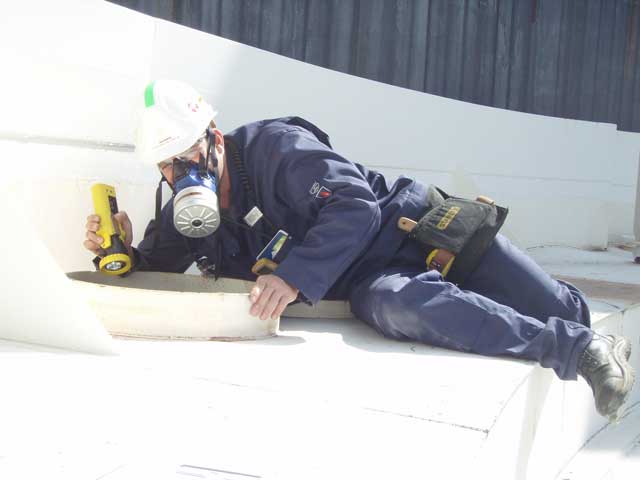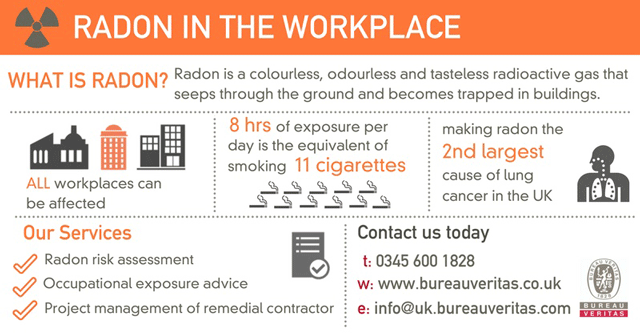
Upcoming changes to the Ionising Radiation Regulations 1999 will revise the maximum levels of radon permissible in the workplace. Ian Mitchell, principal consultant for radon at Bureau Veritas, says companies must act now to comply.
From February this year, the UK will bring in changes to radon control measures that revise the maximum level of radon exposure allowed in the workplace.
In line with World Health Organization recommendations, for commercial buildings that are workplaces this will mean adhering to a revised radon exposure limit of 300 Bq/m³ annual average that will replace the current 400 Bq/m³ over 24 hours maximum exposure levels. The measures are aimed at tackling radon exposure, the second leading cause of lung cancer, as well as harmonising regulations across Europe.
Planned changes to the Ionising Radiation Regulations 1999 are due to be implemented under the EU Basic Safety Standards Directive and will remain in force after Brexit.
What is radon exposure?
Radon is a radioactive, colourless, odourless gas that is naturally present at low levels outdoors but can build up to high concentrations inside some buildings.
Radon decays to produce a series of by-products, such as polonium, which emit radioactive particles that are dangerous to humans when inhaled. They damage the lung cells and are recognised as the cause of up to 2,000 fatal cancers annually, and the third leading cause of premature deaths in the UK.
Levels of radon vary across the UK depending on location and building type. The risk of radon exposure in a building increases dramatically in a geographic area of high radon activity such as Wales and Cornwall (because of the nature of the underlying bedrock).
Workplaces including basements and lower ground floors are at greater risk because of poorer ventilation, and because radon is more likely to enter the building from surfaces in contact with the ground. The risk is higher in densely populated cities, where there is greater demand for office spaces based in lower ground rooms.
 Changing regulations
Changing regulations
Under existing legislation, such as the Health and Safety at Work Act 1974 and the Management of Health and Safety at Work Regulations 1999, all organisations are required to carry out a radon risk assessment. UK workplaces located on below-ground floors or in an area of high radon activity, and which are occupied for more than an average of an hour per week or 52 hours annually, must carry out testing as part of the assessment. Workplaces in areas where it is estimated that more than 1% of properties will be affected by high levels of radon, as defined by Public Health England’s UK radon heat map, must also carry out an assessment.
Where radon workplace levels exceed the current recommended workplace limit of 400Bq/m³, employers are required to notify the HSE and implement an active remediation programme.
Once the new regulations come into force, organisations will need to pursue testing and remediation in the first instance, and will only be required to notify HSE once remediation shows that levels cannot be reduced below the revised 300Bq/m³ annual average.
Time to act now
According to the UK Radon Association, a not-for-profit body promoting radon awareness, it is hoped the new regulations will raise the profile of the harmful effects of radon in the workplace and increase the safety measures for tackling this.
Managing radon exposure should be a priority for organisations, especially as radon levels can be more accurately monitored during winter, making it an ideal time to assess the risk in the workplace.
How is radon measured and reduced?
As radon levels can vary and need to be regularly assessed, repeat testing is required for workplaces currently exceeding exposure limits while every 10 years is sufficient for lower risk environments. It’s common for the majority of workplaces to be assessed every year.
To measure radon in the workplace, an independent testing body such as Bureau Veritas will install specialist radon detectors or digital monitors for a three month test period, in order to establish average radon levels. If unacceptable levels of exposure are detected, a remediation programme is introduced, including a radon “sump” which can be installed beneath the building, which collects radon and redistributes it outdoors via a connecting pipe.
It’s crucial that employers communicate the radon remediation strategy to all employees so they are aware of the measures put in place, and to encourage compliance and, ultimately, the success of the programme.
Overall, the move to update existing legislation on radiation is welcomed, especially as figures show radon exposure accounts for around 50% of the annual personal radiation dose of the average person in the UK, with a significant proportion of an employee’s daily exposure occurring in the workplace. For organisations looking to achieve regulatory compliance, the time to act is now.
Bureau Veritas offers a full range of consultative services in the area of radon risk management. contact 0345 600 1828 or info@uk.bureauveritas.com or visit www.bureauveritas.co.uk

